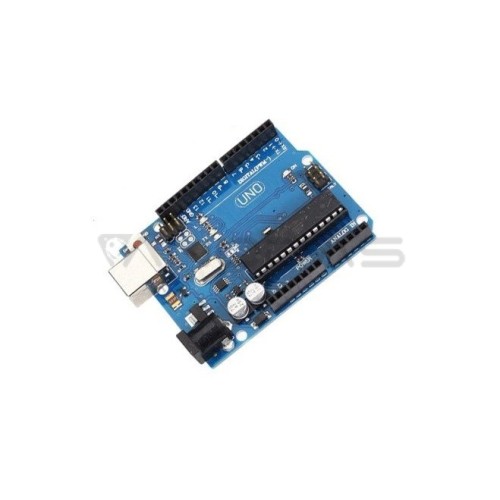UNO R3 - Atmel ATMega328 16MHz - AVR Clone - Compatible with Arduino
Product Code: AN0300
Availability: Vilnius Store Out of Stock
Kaunas Store In Stock
Central Warehouse Out of Stock
Ex Tax: 12.07€
The proposed UNO R3 Atmel is the most popular module on the market, compatible with www.arduino.cc project with ATmega328P.
The UNO R3 can be used in many microprocessor projects.
Arduino is an open source platform based on hardware solutions and easy-to-use software.
Arduino boards use connected sensors and modules that allow you to read various information from the environment, such as turning on a light, pressing a button, reading the temperature, or more complex information, such as reading messages on a computer. This information can be a signal for the Arduino to turn on a motor, light an LED, or announce something to the network. These features give Arduino amazing capabilities with many applications that are only limited by our imaginations.
Features of UNO R3:
- The module is fully compatible with Arduino Uno R3. This means that it can be programmed through the Arduino IDE using the available libraries.
- The module has:
- - ATmega328 microcontroller - the system works with a clock signal with a frequency of 16MHz
- - 14 digital inputs/outputs
- - 6 PWM channels - eg for servo/motor control
- - 6 analog inputs
- - popular communication interfaces
- - USB connection
- - DC power outlet
- - RESET button
- - pins for connecting the AVR programmer
- To run the DFRduino, connect the system to the computer with a USB cable and select the Arduino Uno board in the Arduino IDE environment.
- The module is mostly compatible with shields for Duemilanowe and Diecimila
- By default, the BLINK LED 13 program and bootloader are loaded into the module
Specifications:
- Supply voltage: from 7V to 12V
- Fully compatible with Uno Rev3
- Microcontroller: ATmega328 - operating voltage 5V
- Maximum clock frequency: 16 MHz
- SRAM memory: 2 kB
- Flash memory: 32 kB 5 kB reserved for bootloader
- EEPROM memory: 1 kB
- 14 IN-OUT inputs, including 6 PWM
- The current per pin is 40 mA
- Number of analog inputs: 6 A/D converter channels
- Serial interfaces: UART, SPI, I2C
- External interrupts
- Connection: USB socket
- Soldered ISP connector
- Panel dimensions: 75x54x15mm
- The distance between the pins is 2.54mm, can be mounted on breadboards
Notes on construction and connection
- Food:
- - The module can be powered by a USB cable and an external device such as a power supply, battery or accumulator.
- - The power source is switched automatically.
- - The power supply is connected to a standard DC outlet.
- - A battery or other source is connected to the POWER connector pins.
- Inputs/outputs:
- - The Arduino Pro has 14 digital input/output (I/O) pins.
- - Each pin allows a maximum current of 40 mA, which allows direct connection of LEDs with resistors and control of other integrated circuits.
- - In addition to standard I/O, some contacts have special functions.
- - 6 analog inputs are used to measure voltage (up to 5V!). They can also serve as additional digital pins, in which case we get additional digital pins.
- Programming:
- - The ISCP connector allows you to connect an external AVR programmer. You can find a detailed description in the documentation and the tutorial.
- - The PL2303 programmer can be used for programming via the ISCP connector
- - Programmable via USB using Atmega16u2 intermediate microcontroller





